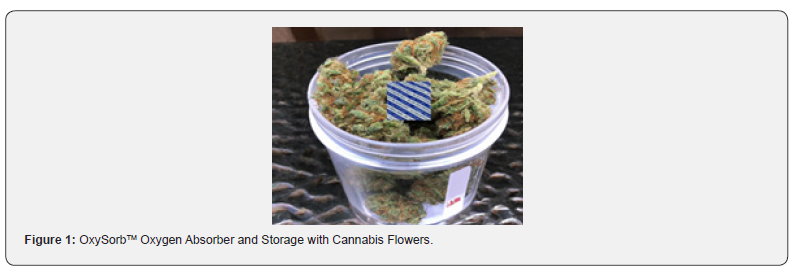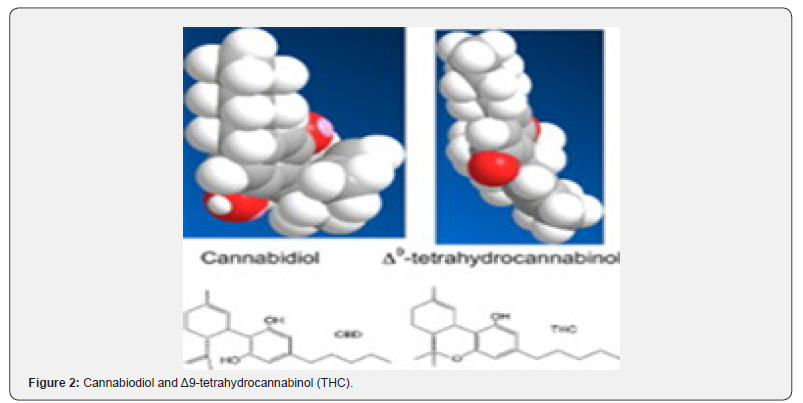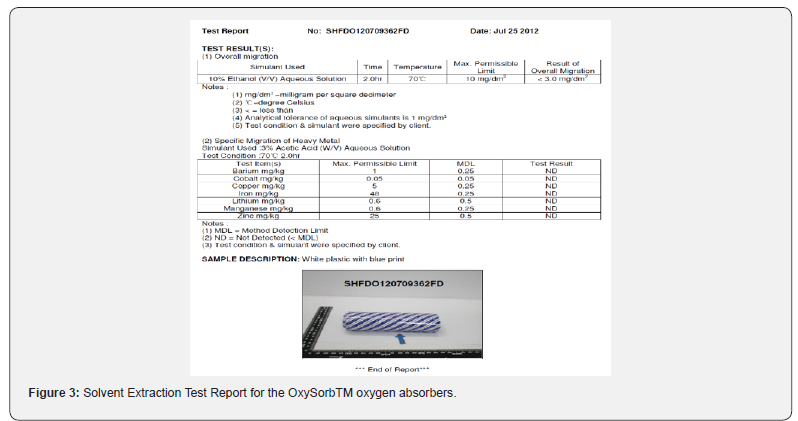Understanding the Risk of CBN Degradation - A Novel use for OxySorbTM & CannaFreshTM Oxygen Absorbers in Cannabis Storage
Simon Cichello*
Department of Veterinary and Agricultural Sciences
Submission: June 20, 2023; Published:June 20, 2023
*Corresponding author:Simon Cichello, Faculty of Veterinary and Agricultural Sciences, University of Melbourne, Melbourne, Australia
How to cite this article:Simon C. Understanding the Risk of CBN Degradation - A Novel use for OxySorbTM & CannaFreshTM Oxygen Absorbers in Cannabis Storage. J Complement Med Alt Healthcare. 2023; 12(1): 555829. DOI: 10.19080/JCMAH.2023.12.555829
Abstract
As cannabis (Cannabis sativa) legalization continues to sweep the globe, more and more people are enjoying the benefits of this muchloved plant. However, with increased use comes greater responsibility - especially when it comes to proper storage. CBN (cannabinol; C21H26O2) formation from the degradation of THC is of major concern[1]. Over time, however, CBN can begin to degrade when exposed to light or oxygen [2]. In fact, law enforcement agencies use the ratio of THC to CBN to estimate the age, and time stored of Cannabis when it has been sold illegally [3]. Cannabinoids in cannabis degrade into simpler compounds that are much less potent than their original form. Degraded terpenes will lead to a decrease in strong flavour and smell, as well as an overall decrease in potency [4], especially the psychoactive THC Δ9- tetrahydrocannabinol (THC). Tetrahydrocannabinol (THC) or C21H30O2 usually refers to the Delta-9-THC isomer with the chemical name (−)-trans-Δ9-tetrahydrocannabinol and is a terpenoid. CBD like the “Yin” or the THC “Yang”, complements the “high” with muscle relaxant, and anti-inflammatory properties [5].
As such, it is important for medicinal cannabis manufacturers and suppliers to ensure there is an oxygen-free environment to reduce potential THC degradation to CBN. One such innovation is the patented [6], OxySorbTM [7] & CannaFreshTM oxygen absorbers and desiccant systems. Wholesale Group International Pty. Ltd. (Australia) is the owner of both trademarks which are currently being trialed with a leading Global Cannabis researcher and manufacturer and the author of this discussion paper. Oxygen absorbers have been shown to be safe and an effective way to preserve food and plant material as per the study by Cichello [8]. Patent is shown in Table 1.
Keywords:Cannabinoids; Cannabis Plant; Ventral Hippocampus; Ventral Hippocampus
Introduction to Cannabinoids and the Cannabis Plant
Cannabinoids are the active compounds found in the cannabis plant. Cannabinoids interact with the body’s endocannabinoid system, which plays a role in many physiological processes including appetite, pain sensation, mood, and memory including but not limited to visceral pain and the brain-gut axis [9]. There are more than 100 different cannabinoids found in cannabis, but the two most well-known and studied are Δ9-tetrahydrocannabinol (THC) and cannabidiol (CBD). They are known for their antiinflammatory effects [10]. See Figure 2., for molecular formulas.
THC is the cannabinoid that produces the “high” associated with Cannabis use. THC binds to cannabinoid receptors located throughout the brain and body, resulting in the psychoactive effects of THC. CBD does not bind to these receptors and does not produce any psychoactive effects [11]. In fact, CBD has been shown to counteract some of the effects of THC. This occurs in the Ventral Hippocampus (VH) through Bidirectional Control of ERK1- 2 Phosphorylation [12]. The VH (anterior in primates) relates to stress, emotion, and affect. The cannabis plant contains more than 5400 different chemicals, including over 100 cannabinoids. The specific ratio of cannabinoids in each strain of cannabis determines its effects on the body [13]. The process of storing cannabis can have a significant impact on its cannabinoid content. For example, sunlight exposure (heat) can cause the degradation of THC into another cannabinoid called CBN (cannabinol) [14]. CBN is less psychoactive than THC but can still produce some psychoactive effects when consumed in large quantities [15].


What is Cannabinol (CBN)?
CBN or cannabinol (C21H26O2) is a cannabis degradation product that is produced when THC-A oxidizes. CBN acts as a low-affinity partial agonist at both CB1 and CB2 receptors. This activity at CB1 and CB2 receptors constitutes the interaction of CBN with the endocannabinoid system (ECS). Oxidation (a loss of an electron) occurs when Delta 9 THC is converted into CBN. CBN has been shown to have deleterious effects on short-term memory and cognition and is also a known carcinogen. However, proponents of cannabis cite a lot of beneficial effects of CBN such as sleep support >5mg, which could assist with memory loss/ impairment-type disorders. However, the pre-clinical and clinical research investigating the effects of CBN is outdated and has small sample sizes, validated through sleep questionnaires with dosages non-therapeutic i.e. (typically ≤5 mg) and ineffective [16]. More worryingly, cannabinoid (CBN) metabolites as Inhibitors of Major Hepatic CYP450 Enzymes that can lead to adverse pharmaceutical drug interactions. Thus, ensuring the accumulation of CBN does not occur by maintaining an oxygen-free environment inside the jars containing medical cannabis. On the other hand, cannabinol’s therapeutic effect may be a useful target for the treatment of memory loss disorders such as Alzheimer’s Disease [17]. Cannabinol’s psychoactive effects are estimated to be 10 times lower than that of THC, with weak psychoactive therapeutic effects [18]. Conversely, Some cytotoxic effects were observed for cannabinol in prostate cancer cell lines DU-145 and LNCaP, and some anti-proliferative effects in aggressive breast cancer cells [19]. Cautiously, cell line studies are in vitro observations with no reference to multi-organ, cell function, and interaction.
How Does CBN Form?
CBN forms when THC degrades. It is not as psychoactive as THC, but it can still produce some weak psychoactive effects on the brain [20]. CBN is produced when THC is exposed to oxygen and light, or when it is stored for long periods of time [21]. To avoid CBN formation and degradation of cannabis, it should be stored in a cool, dark place and in an oxygen-free environment, which supports the notion of use of oxygen absorbers [22], especially the scientifically proven and patented OxySorb Oxygen Absorber, which will maintain the stability of the cannabis in storage. Both colour and odor are two key indicators that Cannabis has degraded without any further scientific investigation [23].
Effects of Heat on THC Degradation
When cannabis is exposed to heat, the THC content degrades and converts into CBN. The rate of THC degradation depends on both the temperature and duration of exposure. For example, storing cannabis at a temperature of 100°F for 24 hours will result in a loss of about 15% THC. However, if the same amount of cannabis is stored at 120°F for the same amount of time, the THC content will degrade by about 30%.
Exposure to high temperatures, pH, and varying humidity can cause changes in the physical appearance of cannabis and the levels of THC (decreases) and CBN (increases). The major cannabinoids (CBD, CBN, and Δ9-THC) reacted more quickly at high temperatures and in an acidic solution [24]. The degradation of THC into CBN is a chemical process that is accelerated by heat. As the THC content degrades, the effects of cannabis change from psychoactive to sedative [25]. Extraction of cannabinoids is best achieved using organic solvents rather than heat [26], and storage in a modified atmospheric packaging with an AquaSorberTM desiccant and OxySorbTM/ CannaFresh Oxygen Absorbers. The film in the OxySorbTM/ CannaFresh Oxygen Absorbers is stable and resistant to solvent extraction in case some solvent remains on the cannabinoid products this will not interfere with the function of the OxySorbTM/ CannaFresh Oxygen Absorbers see Figure 3.


Effects of Humidity and Light on THC Degradation
CBN, or cannabinol, is a degradation product of THC. It is produced when THC is exposed to light and/or air for an extended period [27]. CBN is not as psychoactive as THC, but it can still produce some effects, including drowsiness and disorientation [28]. This could lead to car accidents and industrial/ workplace safety concerns. Cannabis users do not have a higher level of workplace accidents, but increased CBN present in Cannabis and its consumption by patients would change these statistics deleteriously [29]. Furthermore, exposure to humidity can also cause THC to degrade into CBN and more concerningly increased mould and microbial growth which can be harmful to human health [30].
Conclusions
It is recommended that Cannabis is stored with a scientifically proven, biodegradable and patented oxygen absorber, and desiccant such as OxySorbTM and AquaSorberTM. Stability studies and clinical trials are continuing with the use of the novel CannaFreshTM with results being published shortly. Storing cannabis properly is one of the best ways to ensure high-quality, safe marijuana. Present health and safety concerns are that some private-label Cannabis sold in Australia is exposed to oxygen and humidity, and the amount of CBD is higher than recommended and is conferring adverse health effects to patients. However, careless storage practices continue and can have serious consequences: CBN degradation is just one example of this.
Competing Interests
• Simon Cichello PhD is the owner and inventor of
OxySorbTM oxygen absorber and AquaSorberTM desiccant
trademarks and patents.
• He is also a shareholder of Little Green Pharma Limited
(Australia), and joint owner of CannaFreshTM
• Hélène Klein is the Chief Pharmacist of Little Green
Pharma Limited (ASX: LGP).
References
- M A Huestis (2005) Pharmacokinetics and metabolism of the plant cannabinoids, delta9-tetrahydrocannabinol, cannabidiol and cannabinol. Handb Exp Pharmacol (168): 657-690.
- Fraguas-Sánchez AI, Fernández-Carballido A, Martin-Sabroso C, Torres-Suárez AI (2020) Stability characteristics of cannabidiol for the design of pharmacological, biochemical and pharmaceutical studies. Journal of Chromatography B, 1150: 122188.
- Ross SA, ElSohly MA. CBN and delta-9-tetrahydrocannabinol ratio as an indicator of the age of stored marijuana samples. Bulletin on Narcotics. 49/50(1&2): 139-147.
- Yangsud J, Santasanasuwan S, Ahkkarachinoreh P, Maha A, Madaka F, et al. (2021) Stability of cannabidiol, ∆9-tetrahydrocannabinol, and cannabinol under stress conditions. Advances in Traditional Medicine 21: 475-484.
- Pennypacker SD, Romero-Sandoval EA (2020) CBD and THC: Do They Complement Each Other Like Yin and Yang? Pharmacotherapy 40(11): 1152-1165.
- A 100% biodegradable Oxygen Absorber with anti-microbial properties and its recyclable use as a soil fertilizer
- Chemical products in this class being oxygen absorbers, oxygen scavengers, oxygen and carbon dioxide absorbers/ scavengers; Chemicals contained within paper and plastic bags and/ or sachets containing oxygen absorber/ and or carbon dioxide absorbing/ scavenger products for use in the agriculture, food, or pharmaceutical industry 2018.
- Cichello SA (2015) Oxygen absorbers in food preservation: a review. J Food Sci Technol 52(4): 1889-1895.
- Sharkey KA, Wiley JW (2015) The Role of the Endocannabinoid System in the Brain-Gut Axis. Gastroenterology. 151(2): 252-266.
- Burstein S (2015) Cannabidiol (CBD) and its analogs: A review of their effects on inflammation. Bioorganic & Medicinal Chemistry 23(7): 1377-1385.
- Pertwee RG (2008) The diverse CB1 and CB2 receptor pharmacology of three plant cannabinoids: delta9-tetrahydrocannabinol, cannabidiol and delta9-tetrahydrocannabivarin. Br J Pharmacol 153(2): 199-215.
- Hudson R, Renard J, Norris, C, Rushlow W, and Laviolette S (2019) Cannabidiol Counteracts the Psychotropic Side-Effects of Δ-9-Tetrahydrocannabinol in the Ventral Hippocampus through Bidirectional Control of ERK1-2 Phosphorylation. Journal of Neuroscience, 39(44): 8762-8777.
- Zerrin Atakan (2012) Cannabis, a complex plant: different compounds and different effects on individuals. Ther Adv Psychopharmacol 2(6): 241–254.
- Repka MA, ElSohly MA, Munjal M, Ross SA (2006) Temperature stability and bioadhesive properties of 9-tetrahydrocannabinol incorporated hydroxypropylcellulose polymer matrix systems. Drug Dev Ind Pharm 32(1): 21-32.
- Huestis MA (2007) Human cannabinoid pharmacokinetics. Chem Biodivers 4(8): 1770-1804.
- Corroon J (2021) Cannabinol and Sleep: Separating Fact from Fiction. Cannabis Cannabinoid Res 6(5): 366-371.
- Abate G, Uberti D, Tambaro S (2021) Potential and Limits of Cannabinoids in Alzheimer's Disease Therapy. Biology (Basel). 10(6):542.
- Huestis MA (2005) Pharmacokinetics and metabolism of the plant cannabinoids, Δ9-tetrahydrocannibinol, cannabidiol and cannabinol. In: Pertwee R.G., editor. Volume 168. Springer; Berlin/Heidelberg, Germany: 657-690.
- McAllister SD, Christian RT, Horowitz MP, Garcia A, Desprez PY (2007) Cannabidiol as a novel inhibitor of Id-1 gene expression in aggressive breast cancer cells. Mol. Cancer Ther 6: 2921-2927.
- Sharma P, Murthy P, Bharath MM. Chemistry, metabolism, and toxicology of cannabis: clinical implications. Iran J Psychiatry.;7(4):149-56.
- Fairbairn JW, Liebmann JA, Rowan MG (1976) The stability of cannabis and its preparations on storage. J Pharm Pharmacol. 28(1):1-7.
- Cichello SA. Oxygen absorbers in food preservation: a review. J Food Sci Technol 52(4): 1889-1895.
- Rice S, Koziel JA Characterizing the Smell of Marijuana by Odor Impact of Volatile Compounds: An Application of Simultaneous Chemical and Sensory Analysis. Plos One. 10(12): e0144160.
- Jaidee W, Siridechakorn I, Nessopa S, Wisuitiprot V, Chaiwangrach N, et al. 2021) Kinetics of CBD, Δ9-THC Degradation and Cannabinol Formation in Cannabis Resin at Various Temperature and pH Conditions. Cannabis Cannabinoid Res 7(4): 537-547.
- The Health Effects of Cannabis and Cannabinoids: The Current State of Evidence and Recommendations for Research. Washington (DC): National Academies Press (US) (2017) National Academies of Sciences, Engineering, and Medicine; Health and Medicine Division; Board on Population Health and Public Health Practice; Committee on the Health Effects of Marijuana: An Evidence Review and Research Agenda.
- Lazarjani MP, Young O, Kebede L, Seyfoddin A (2021) Processing and extraction methods of medicinal cannabis: a narrative review. J Cannabis Res 3(1): 32.
- Zamengo L, Bettin C, Badocco D, Di Marco V, Miolo G (2019) The role of time and storage conditions on the composition of hashish and marijuana samples: A four-year study. Forensic Sci Int 298: 131-137.
- Kaul M, Zee PC, Sahni AS (2021) Effects of Cannabinoids on Sleep and their Therapeutic Potential for Sleep Disorders. Neurotherapeutics 18(1): 217-227.
- Zhang JC, Carnide N, Holness L, Cram P (2020) Cannabis use and work-related injuries: a cross-sectional analysis. Occup Med (Lond). 70(8): 570-577.
- Das PC, Vista AR, Tabil LG, Baik OD (2022) Postharvest Operations of Cannabis and Their Effect on Cannabinoid Content: A Review. Bioengineering (Basel) 9(8): 364.






























